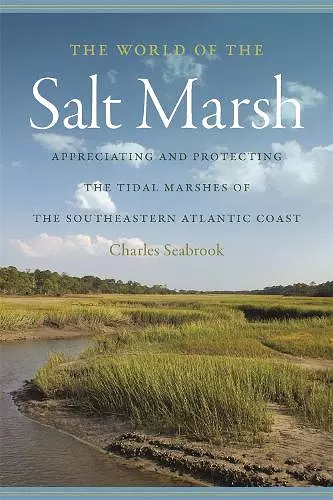The World of the Salt Marsh
Appreciating and Protecting the Tidal Marshes of the Southeastern Atlantic Coast
Format:Paperback
Publisher:University of Georgia Press
Published:1st May '13
Currently unavailable, and unfortunately no date known when it will be back

The World of the Salt Marsh is a wide-ranging exploration of the southeastern coast—its natural history, its people and their way of life, and the historic and ongoing threats to its ecological survival.
Focusing on areas from Cape Hatteras, North Carolina, to Cape Canaveral, Florida, Charles Seabrook examines the ecological importance of the salt marsh, calling it “a biological factory without equal.” Twice-daily tides carry in a supply of nutrients that nourish vast meadows of spartina (Spartina alterniflora)—a crucial habitat for creatures ranging from tiny marine invertebrates to wading birds. The meadows provide vital nurseries for 80 percent of the seafood species, including oysters, crabs, shrimp, and a variety of finfish, and they are invaluable for storm protection, erosion prevention, and pollution filtration.
Seabrook is also concerned with the plight of the people who make their living from the coast’s bounty and who carry on its unique culture. Among them are Charlie Phillips, a fishmonger whose livelihood is threatened by development in McIntosh County, Georgia, and Vera Manigault of Mount Pleasant, South Carolina, a basket maker of Gullah-Geechee descent, who says that the sweetgrass needed to make her culturally significant wares is becoming scarcer.
For all of the biodiversity and cultural history of the salt marshes, many still view them as vast wastelands to be drained, diked, or “improved” for development into highways and subdivisions. If people can better understand and appreciate these ecosystems, Seabrook contends, they are more likely to join the growing chorus of scientists, conservationists, fishermen, and coastal visitors and residents calling for protection of these truly amazing places.
The potential impact of The World of the Salt Marsh on society will be similar to the impact Silent Spring and A Sand County Almanac had in their time. Seabrook is a natural storyteller, and the book should be enjoyed by anyone with an interest in life along our coasts.
-- Fred Holland * former director of NOAA’s Hollings Marine Laboratory *Charles Seabrook spent his childhood next to a marsh, and in this marvelous and insightful book he shares his intimate knowledge and his love of these unique green meadows that fill the sounds and bays behind barrier islands. With numerous interviews of scientists and colorful local characters and with Seabrook as our guide, we envision the geologic history of the lower coastal plain of the southeastern U.S., see the sights, observe the plants and animals, hear the sounds, and even smell the smells of the marshes. Irrevocably intertwined with nature here is the fascinating cultural history from Native Americans through the slave culture of the plantations right up to the environmental impact of today’s human rush to the shore. Breathtaking in its scope and highly readable, this book is a must-read for those interested in coasts and concerned for their future.
-- Orrin H. Pilkey * coauthor of The World's Beaches: A Global Guide to the Science of the Shoreline *Told through the life experiences of his friends and colleagues—fisherman, crabbers, oystermen and other—the author’s story frequently returns to his main theme: the destruction of this important environmental resource. . . . [Including] history, a summary of contemporary scientific research and current legislative initiatives. . . . [The World of the Salt Marsh is] another excellent wake-up call about the need to prevent the destruction of our natural environment.
-- Kirkus ReviewsYou can read The World of the Salt Marsh cover to cover, or dip into it at random, but be prepared to get hooked at any point. The Wild Georgia columnist is a most entertaining and knowledgeable tour guide, whether nibbling a saltwort leaf that resembles a 'moist potato chip' and tastes 'great in stuffed crab'; teaching an impromptu lesson on how to wriggle out of quicksand-like 'pluff mud' by 'belly-crawling' across it; or in his description of the imperiled diamondbacked terrapin: 'Imagine a reptile with the dreamy eyes of a golden retriever and the unassuming face of a manatee. Add the docile temperament of a lamb and the beauty of a seashell.'
-- Gina Webb * Atlanta Journal-Constitution *This book is highly recommended to anyone who shares our respect of the salt marsh and would like to learn about its biology and culture.
-- David Whitaker and Billy McCord * Post and Courier *In this book, [Seabrook] takes a very personal—but still beautifully reported—journey as he explores the Southeastern U.S. coast, from Cape Hatteras, North Carolina, to Cape Canaveral, Florida. A native of Johns Island, South Carolina, Seabrook delves into natural history and ecological threats without letting the poetry of the marsh get lost in the science.
-- Teresa Weaver * Atlanta Magazine *At first glance . . . The World of the Salt Marsh is the poignant story of the coast. On second glance, the richly woven layers of this compelling narrative blend coastal culture and natural history with saltwater ecosystem dynamics to educate and inform. . . . This book provides a clear shapshot of the life and times of a salt marsh in today's fast-paced world. Just as clearly, it illustrates the need for stewardship and education among people whose activities impact the ecosystem. Carefully researched and thoughtfully illustrated with 52 crisp black and white photos, The World of the Salt Marsh is a book for your keeper shelf.
-- Margaret Toussaint * Darien News *In The World of the Salt Marsh, Charles Seabrook's masterful and comprehensive examination of what remains of these endangered and disappearing wetlands, the native of Johns Island, SC explains why we should be 'appreciating and protecting the tidal marshes of the southeastern coast.'
-- C. F. Foster * Florida Times-UnionISBN: 9780820345338
Dimensions: 229mm x 152mm x 25mm
Weight: 517g
380 pages